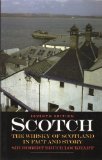 Scotch: The Whiskey of Scotland in Fact and Story by Sir Robert Bruce Lockhart, K. C. M. G. Putnam and Company, 1974, 184 pages, $19.74 US.
Scotch: The Whiskey of Scotland in Fact and Story by Sir Robert Bruce Lockhart, K. C. M. G. Putnam and Company, 1974, 184 pages, $19.74 US.
Brief overview of content:
Being a fine Scotsman, the author discusses the history of scotch whiskey from the early days as the drink of the people in the Highlands of Scotland, where if not everybody, at least every town had someone distilling the aqua vitae beloved the world over. He chronicles the times of repression and taxation, when stills were hidden and whiskey was smuggled all over the country. With the invention of the patent still (allowing a more industrial production) and the popularity of blended whiskeys, the 1800s saw the rise of popularity of scotch whiskey outside Scotland. Initially it was promoted in England and then to the rest of the world. The rise of the "big five" distillers (Dewars, Walkers, Buchanans, Haigs, and Mackies) is chronicled with charming details. The impact of consolidation in the Distillers Company Limited (which the big five managed to avoid) is described along with various conflicts over what should count as whiskey. The author clearly favors "Scotch malt whisky which is distilled in Scotland in a simple pot-still from a mash consisting entirely of malted barley." [p. 3]The 20th century history is also chronicled, with the impacts of two world wars and American prohibition being the main events. The book was written in the 1950s, so much of the recent history is not covered.
Author overview:
Blurb from the wikipedia article: Sir Robert Hamilton Bruce Lockhart KCMG (2 September 1887 – 27 February 1970), was a journalist, author, secret agent, British diplomat in Moscow and Prague, and footballer. His 1932 book Memoirs of a British Agent became an international bestseller, and brought him to the world’s attention.Recommendations:
1. Read cover to cover vs. consult as needed.
The book is an entertaining read throughout and I would recommend reading the whole thing. If you are doing a school report on the real Johnnie Walker, you could use the index in the back which is pretty thorough (it has ten entries that start with the word "whiskey," though none with the word "Scotch." The author probably assumes they're synonyms).2. Readability.
While the text is not challenging, some information is assumed. The author refers several times to "The Forty-Five" as if it is some famous event, set of people, or vinyl record everyone knows about. This last joke is, of course, lost on most young readers, who probably assume music comes from iTunes, or, if you are desperate, actual musical instruments and singers. But I digress. Now that I am writing this review, I've googled it and found out what it is--the Jacobite uprising of 1745 attempting to restore the Stuarts to the throne of Scotland and England.3a. Helpful to a parent?
The book is full of entertaining anecdotes about the colorful people involved in the whiskey trade which might make for good bedtime stories, though they may be too entertaining for the child to fall asleep.I feel compelled to share one personal family story. My eldest brother had some tough times when he was teething as an infant. My mom asked for some advice and one of the neighbors recommended a little whiskey to soothe the aching gums. The neighbor meant to tell my mom to rub some scotch on his gums; instead, she gave him a little shot in his bottle. He slept soundly for 24 hours! He grew up perfectly normal (at least, more normal than me), so no harm done.
3b. Helpful to a hopeful distiller?
While the process of distilling whiskey is described, it is not done in enough detail to recreate Scotch without a lot of trial and error. Also, the author is highly in favor of locally made whiskey, so unless you live in Scotland (preferably the Highlands), the book may be discouraging.3c. Helpful to a drinker?
Having recently gone to a Scotch tasting hosted by a Highlander, I can say that the book didn't cover much of what we drank. Glenlivet was the only one I recognized from the book. The Scotchs were all single malts from the Highlands (with one from the Lowlands that the host called "breakfast Scotch"). The history is pretty interesting and made for some good cocktail party conversation fodder.4. Did we use it?
We have not put the book to use, alas.Sample text
On the medicinal use of Scotch whiskey:Although whisky, in the Highlands at any rate, is still regarded as a spirit not to be adulterated or tampered with, I must admit that there were and are receipts for its use as a medicine and also for the final glory of a feast, receipts far more ancient than the blended whisky which we drink to-day. Of these the best known are toddy and Atholl borse. Toddy, excellent both as a cure for cold and as an elixir of life, requires careful preparation. The ingredients are sugar, boiling water and preferably a well-matured malt whisky. First, you heat the tumbler with warm water and, when the glass has reached a comfortable temperature, you pour out the water. Then into the empty glass you put two or three squares of loaf-sugar and add enough boiling water--a wine-glass should suffice--to dissolve the sugar. Then add a wine-glass of whisky and stir with a silver spoon; then another wine-glass of boiling water, and finally to crown this liquid edifice top it with another wine-glass of whisky. Stir again and drink the contents with slow and loving care. As a cure for cold, take your toddy to bed, put one bowler hat at the foot, and drink until you see two. [p. 14]



No comments:
Post a Comment